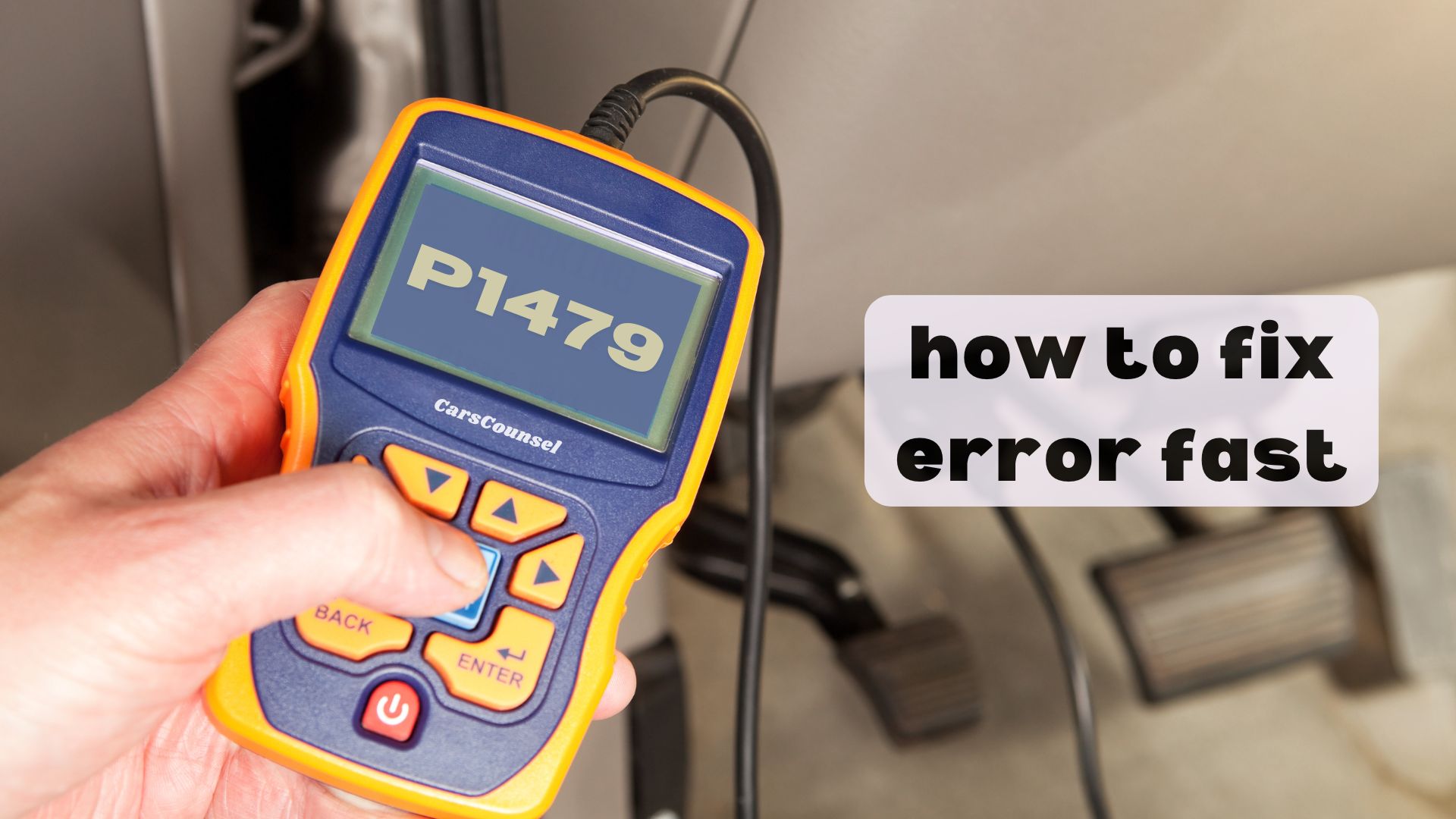Imagine your car’s cooling system is like a well-choreographed dance, with each component working in harmony to keep your engine at the perfect temperature. But when the primary control circuit responsible for managing the cooling fan malfunctions, it’s like the lead dancer trips, throwing the entire performance off balance. That’s what’s happening when your car throws a P1479 code, indicating a critical issue that can lead to fan failure and engine overheating if left unchecked. What’s causing this malfunction, and how can you get your cooling system back in sync?

Quick Navigation
Key Takeaways
- The P1479 code indicates a critical issue with the primary control circuit responsible for managing the cooling fan’s operation, which can lead to fan failure and engine overheating.
- Faulty components, such as the cooling fan relay, wiring issues, or a malfunctioning temperature sensor, can trigger the P1479 code and cause fan failure.
- Symptoms of the P1479 code include engine overheating, high engine temperature gauge readings, and poor air conditioning performance, which can lead to engine damage if left unchecked.
- To diagnose and fix the P1479 code, connect a scan tool to the vehicle’s onboard computer, perform a thorough fault diagnosis, and check the cooling fan relay, wiring connections, and temperature sensor for any signs of malfunction.
- The cost to fix the P1479 code can range from $150 to $500, depending on the specific cause of the issue and the extent of the repairs needed.
Code P1479 Description
When your vehicle’s onboard computer triggers the P1479 code, it indicates a critical issue with the primary control circuit responsible for managing the cooling fan’s operation.
Critical issue detected: onboard computer triggers P1479 code, signaling malfunction in primary control circuit managing cooling fan operation.
This malfunction can lead to fan failure, causing your engine to overheat. The primary control circuit is responsible for regulating the cooling fan’s speed and operation.
A circuit overload or fan failure can result in serious engine damage if left unaddressed. It’s essential to address this issue promptly to prevent costly repairs.
The P1479 code serves as a warning, alerting you to a critical problem that requires immediate attention.
Common Causes of P1479
The primary control circuit of your vehicle’s cooling fan is susceptible to various faults, which can trigger the P1479 code.
You may experience fan failure, leading to cooling issues, due to a faulty cooling fan relay, wiring issues, or a malfunctioning temperature sensor.
A defective cooling fan motor can also cause the fault code to appear. Additionally, other possible causes not listed here may trigger the P1479 code.
It’s essential to identify the root cause to address the issue promptly and prevent engine damage.
Symptoms of P1479
Your vehicle’s failure to regulate engine temperature can manifest in various ways, signaling a potential problem with the cooling fan. If the fan fails to operate correctly, it can lead to overheating of the engine, resulting in serious damage. Here are some common symptoms to look out for:
| Symptom | Description |
|---|---|
| Engine Overheating | The engine temperature gauge rises above normal levels, indicating a cooling system issue. |
| High Engine Temperature Gauge Readings | The dashboard temperature gauge shows higher than normal readings, signaling a potential cooling fan failure. |
| Poor Air Conditioning Performance | The air conditioning system may not function properly, leading to reduced cooling performance. |
Watch out for these signs, as fan failure can cause engine damage if left unchecked.
How to Fix P1479
One crucial step in resolving the P1479 code is to diagnose the issue accurately.
Once you’ve identified the problem, you can start repairing the high fan control primary circuit malfunction. Check the cooling fan relay and replace it if necessary.
Inspect wiring connections for damage or corrosion and repair or replace them as needed.
Test the temperature sensor to verify it’s sending correct signals to the cooling fan.
If the fan motor is faulty, replace it to restore proper fan speed and cooling system function.
Diagnosing the Issue
You’re about to plunge into the diagnostic process for the P1479 code, and it’s essential to approach this step methodically to identify the root cause of the High Fan Control Primary Circuit Malfunction.
Start by connecting a scan tool to your vehicle’s onboard computer to retrieve trouble codes and live data. This will help you pinpoint the faulty component or circuit.
Perform a thorough fault diagnosis, checking the cooling fan relay, wiring connections, and temperature sensor for any signs of malfunction.
Cooling Fan Relay Replacement
The cooling fan relay plays a vital role in the primary control circuit, as it supplies power to the fan motor. When troubleshooting, you’ll need to analyze the relay circuit to identify any issues. Here’s a breakdown of the fan relay troubleshooting process:
| Step | Action |
|---|---|
| 1 | Check the relay’s electrical connections for signs of wear or corrosion |
| 2 | Use a multimeter to test the relay’s voltage and resistance |
| 3 | Inspect the relay’s internal components for signs of damage or wear |
| 4 | Replace the relay if any issues are found during testing |
Wiring Connection Inspection
Two critical areas to inspect when troubleshooting the P1479 code are the wiring connections between the cooling fan relay and the fan motor, as well as the connections to the temperature sensor.
You’ll want to check for signs of wire damage, corrosion, or faulty connections that could be disrupting the flow of electricity.
Check for signs of wire damage, corrosion, or faulty connections that could be disrupting the flow of electricity.
Inspect the wiring connections carefully and look for:
- Cracked or frayed wires that can cause shorts or open circuits.
- Corrosion or rust on the connectors or terminals.
- Loose or broken connections that can interrupt the signal.
- Melted or burned insulation that indicates overheating.
Repair or replace any damaged wiring or connections to guarantee proper operation of the cooling fan.
Temperature Sensor Testing
During temperature sensor testing, your goal is to verify that the sensor is sending accurate signals to the cooling fan control module.
You’ll need to check the sensor’s calibration to guarantee it’s providing correct readings. Faulty readings can lead to incorrect cooling fan operation, exacerbating engine overheating issues.
Use a multimeter to measure the sensor’s output voltage, comparing it to the manufacturer’s specifications. If the readings are inconsistent, the sensor may be faulty, requiring replacement.
Proper sensor calibration is vital for accurate temperature readings, certifying the cooling fan operates correctly to prevent engine damage.
Cooling Fan Motor Replacement
You’ve identified a faulty temperature sensor, now it’s time to focus on replacing the cooling fan motor if it’s defective.
A faulty motor can significantly impact fan performance and motor efficiency, leading to overheating issues.
To guarantee a successful replacement, follow these steps:
- Disconnect the battery: Prevent any accidental starts or electrical shocks.
- Remove the fan shroud: Gain access to the cooling fan motor.
- Disconnect electrical connections: Carefully detach the wiring harness from the motor.
- Install the new motor: Mount the replacement motor securely and reconnect electrical connections.
Cost to Fix P1479 and Additional Information
About $150 to $500 is what you can expect to pay to fix the High Fan Control Primary Circuit Malfunction, depending on the specific cause of the issue and the extent of the repairs needed.
This estimate covers the cost of parts, ranging from $50 to $200, and labor costs, which can be between $100 and $300.
The final cost will depend on factors like your vehicle’s make and model, the repair shop’s location, and the type of engine.
For peak fan performance, it’s vital to address this issue promptly to prevent engine overheating and potential damage.
More OBD-II Codes
| P1480 | P1481 | P1482 | P1483 |
| P1484 | P1485 | P1486 | P1291 |
| P1292 | P1293 | P1294 | P1226 |
| P1209 | P1210 | P1204 | P1202 |
| P1203 | P1198 | P1146 | P1145 |
| P1144 | P1143 | P1142 | P1140 |
Frequently Asked Questions
Can a Faulty Cooling Fan Cause Damage to Other Engine Components?
If your cooling fan fails, you risk overheating, which can damage other engine components. A faulty fan motor can lead to warped cylinder heads, cracked engine blocks, or damaged head gaskets, emphasizing the need for a thorough cooling system inspection.
Will a P1479 Code Cause My Car’s Air Conditioning to Malfunction?
As you wonder if your car’s air conditioning will malfunction, the answer lies in the fan speed and cooling performance. Yes, a malfunctioning cooling fan can impact your AC’s performance, causing reduced airflow and inefficient cooling, leaving you sweltering on a hot day.
Can I Drive My Car With a P1479 Code Without Damaging the Engine?
You can drive your car with a malfunctioning fan, but it’s risky. Reduced fan performance and cooling capacity can cause engine overheating, leading to serious damage. It’s recommended to address the issue promptly to avoid costly repairs.
How Long Does It Take to Repair a P1479 Code on Average?
You can expect fan repair to take around 1-3 hours, depending on diagnostic complexity and the underlying issue. If it’s a simple relay replacement, it’ll be on the shorter side, but if it’s a more intricate wiring or sensor problem, it may take longer.
Will a P1479 Code Trigger a Check Engine Light on My Dashboard?
As you cruise down the highway, your dashboard suddenly illuminates like a warning lighthouse, signaling trouble. In this scenario, you’re likely wondering if a faulty fan diagnosis will trigger a check engine light, compromising engine performance, and the answer is yes, it probably will.
Conclusion
As you put the pieces of the puzzle together, a clear picture emerges: a faulty primary control circuit is the root of the problem. Don’t let engine overheating simmer in the background, address the P1479 code head-on. By methodically diagnosing and replacing faulty components, you’ll prevent engine damage and get your cooling fan humming like a well-oiled machine. Remember, a stitch in time saves nine – tackle the issue now to avoid a costly meltdown down the road.

